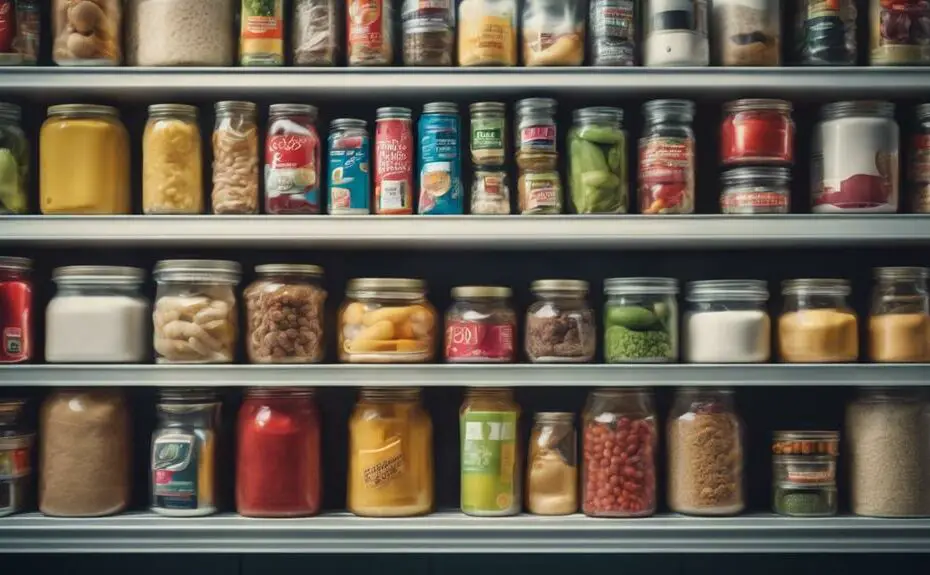When I find myself with a surplus of tomatoes, I'm faced with a decision: should I vacuum seal them or can them? Each method has its advantages and disadvantages. Vacuum sealing is a modern and efficient approach that preserves freshness and extends shelf life without the need for heat processing. However, it does require an initial investment in equipment. On the other hand, canning is a traditional technique that can potentially provide longer storage, but it requires more labor and skill.
As I weigh the pros and cons, I realize that vacuum sealing offers convenience and efficiency. By removing the air from the packaging, it helps to preserve the flavor, texture, and nutrients of the tomatoes. This method is particularly beneficial for items that are sensitive to heat, such as delicate fruits and vegetables. Vacuum-sealed tomatoes can be stored in the freezer for an extended period without the risk of freezer burn.
On the other hand, canning has been a tried and true method of food preservation for centuries. It involves heat processing the tomatoes in jars, which kills bacteria and enzymes that cause spoilage. This method can provide a longer shelf life, allowing me to enjoy the tomatoes throughout the year. However, it requires more time and effort, as the tomatoes need to be peeled, processed, and sealed in jars. Additionally, there is a risk of jars breaking or lids failing, which can lead to spoilage.
In terms of equipment, vacuum sealing requires a vacuum sealer machine and bags or containers specifically designed for this method. While the initial investment can be costly, the machine can be used for various other food items, making it a versatile tool in the kitchen. On the other hand, canning requires jars, lids, and a large pot for the heat processing. These items are relatively inexpensive and can be reused for multiple canning projects.
Ultimately, the choice between vacuum sealing and canning depends on my specific needs and preferences. If I want to preserve the freshness of the tomatoes and have quick and easy access to them, vacuum sealing is the way to go. However, if I prioritize longer storage and don't mind investing more time and effort, canning can be a reliable option.
In conclusion, both vacuum sealing and canning have their merits and drawbacks when it comes to food preservation. Vacuum sealing offers convenience and freshness preservation, while canning provides longer shelf life. Consider your specific needs and preferences to determine which method is best for you.
Overview of Vacuum Sealing
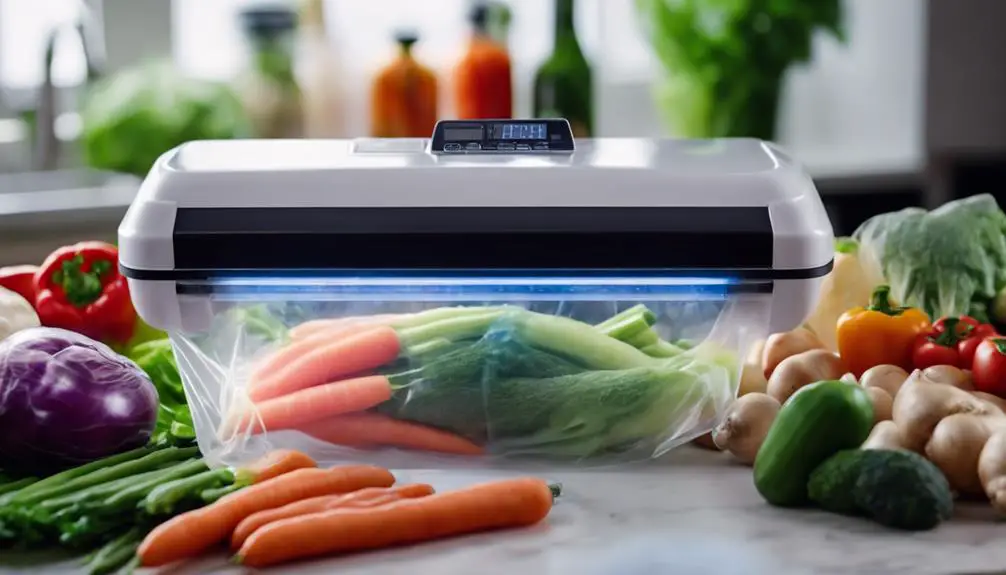
Vacuum sealing is a fantastic method for extending the shelf life of food. It's a simple yet effective technique that removes air from a plastic bag and seals in the freshness. This has been a game-changer in my kitchen, helping me save time and money. By removing the air, vacuum sealing slows down the degradation process, reducing oxidation and inhibiting the growth of bacteria and mold.
What sets vacuum sealing apart from traditional methods like canning or freezing is its speed and efficiency. It doesn't require heat, making it a modern and convenient option for food preservation. I've discovered that vacuum sealing isn't only great for storing leftovers or bulk purchases, but it also enhances marinating and sous vide cooking. It has opened up a whole new world of culinary possibilities for me.
However, it's important to note that vacuum sealing isn't a one-size-fits-all solution. Different foods require different handling and storage techniques to ensure safety and quality. But as I've integrated vacuum sealing into my routine, I've found it to be an indispensable tool in my kitchen arsenal. It's perfectly suited for our fast-paced, waste-conscious world.
To make the most of vacuum sealing, here are a few tips. Firstly, always make sure to label the bags with the contents and date. This will help you keep track of what you've stored and when it was sealed. Secondly, consider investing in a high-quality vacuum sealer. There are many options available on the market, so do your research and choose one that suits your needs. Lastly, be mindful of the texture and moisture content of the food you're vacuum sealing. Some foods, like delicate fruits or moist meats, may require pre-freezing or partial vacuum sealing to prevent crushing or moisture buildup.
Benefits of Vacuum Sealing
Vacuum sealing has become a game-changer in food preservation, revolutionizing how we store and maintain the freshness of our meals. This method offers a multitude of benefits that have completely transformed my approach to food storage. Let's delve into these advantages that have simplified my life and elevated the quality of my meals.
First and foremost, vacuum sealing extends the shelf life of food by a significant margin. By removing the air, which is the main culprit behind food spoilage, vacuum sealing slows down the deterioration process. This means that I can now enjoy my favorite foods for a longer period of time without compromising on taste or nutritional value.
Another notable benefit is the protection it provides against freezer burn. By creating an airless environment, vacuum sealing prevents the dehydration and oxidation that freezer burn causes. As a result, my frozen goods retain their original texture and flavor, making them much more appetizing and enjoyable.
In addition to preserving the quality of food, vacuum sealing also offers space efficiency. The compact nature of vacuum-sealed packages has revolutionized my fridge and freezer organization. I can now store more in the same amount of space, making it easier to keep my kitchen tidy and my ingredients easily accessible.
Furthermore, the versatility of vacuum sealing is truly remarkable. It can be used for a wide range of food types, including meats, vegetables, dry goods, and even liquids. This makes it an indispensable tool in my kitchen, accommodating all my storage needs with ease.
Drawbacks of Vacuum Sealing
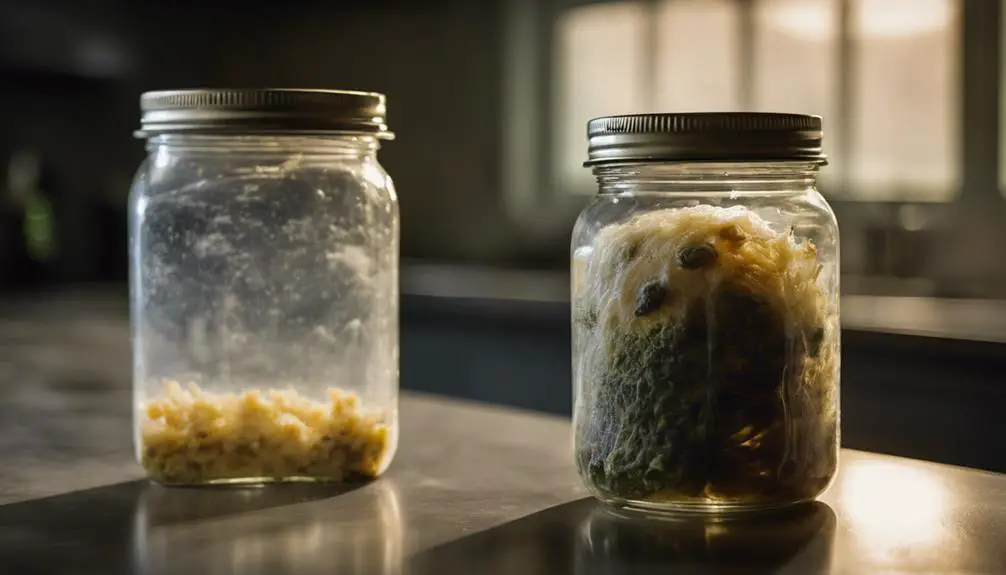
While vacuum sealing has its advantages, it's important to acknowledge its limitations and challenges. One drawback is the initial investment. It's not just the cost of the machine, but also the ongoing expense of purchasing specialized bags or rolls. Over time, these costs can add up.
Another limitation is that vacuum sealing isn't a one-size-fits-all solution. Delicate items can be crushed under the pressure of the vacuum, and sealing liquids can be tricky without creating a mess or compromising the seal's integrity.
Additionally, there's a learning curve to using a vacuum sealer. It takes time to figure out the right amount of bag to leave for sealing and to master the technique of sealing liquids without any spills. It's important to note that vacuum sealing isn't a substitute for refrigeration or freezing. While it can significantly extend the shelf life of food, it doesn't prevent spoilage indefinitely. Therefore, it's still necessary to monitor the freshness of the food.
Despite these drawbacks, vacuum sealing offers a sleek and space-saving way to preserve food. It's a valuable tool in any modern kitchen, but it does come with some limitations that need to be considered. It requires an upfront investment, ongoing costs, and some practice to master. However, with the right approach and understanding of its limitations, vacuum sealing can be a great asset in preserving food.
Understanding Canning
Canning is an age-old method used to effectively preserve food. Unlike vacuum sealing, which simply removes air, canning goes a step further by sealing the food in airtight containers and sterilizing it. This sterilization process kills potentially harmful bacteria and enzymes, making canning a trusted method for generations.
To understand canning better, let's break down the process:
- Selection and Preparation: The first crucial step in canning is choosing fresh, high-quality produce or prepared foods. This ensures that the final product will be of the best quality.
- Sterilization: Before filling the jars, it's important to sterilize them and the lids. This step ensures that no contaminants are sealed inside the jars, keeping the food safe for consumption.
- Filling and Sealing: Once the jars are sterilized, the foods are packed into them, leaving some headspace. This headspace allows for expansion during the canning process. The jars are then sealed with lids to create an airtight environment.
- Processing: The sealed jars are then processed either in a water bath or a pressure canner. This step is crucial as it kills bacteria and creates a vacuum seal, ensuring the food's long-term preservation.
The combination of sealing and sterilizing is what makes canning such a reliable method for preserving food. It's a practice that blends tradition with science, offering a fascinating glimpse into the world of food preservation.
Advantages of Canning
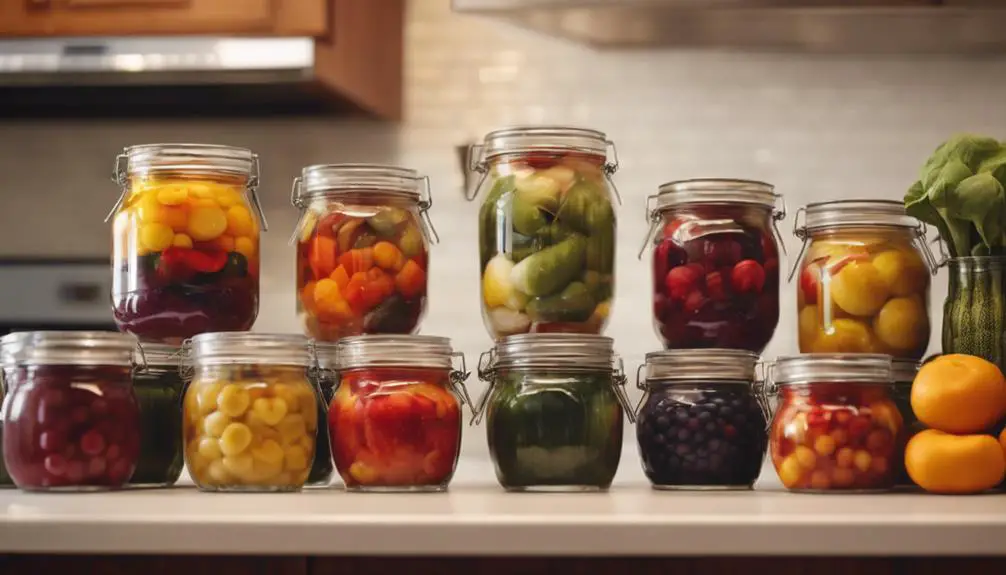
Canning isn't only a traditional method but also an incredibly efficient way to preserve food. It offers a range of benefits that make it a popular choice for modern kitchens.
One major advantage of canning is its ability to provide long shelf life for foods. Canned foods can last for years without the need for refrigeration. This not only reduces food waste but also helps save money in the long run. Imagine having a pantry stocked with canned goods that can be enjoyed at any time, regardless of seasonal availability.
Another benefit of canning is the retention of nutrients in food. Proper canning techniques ensure that most of the essential nutrients are preserved. This means that even after months or years of storage, the canned food remains healthy and nutritious. It's reassuring to know that the food you've preserved retains its nutritional value.
Canning also offers great versatility. Almost any type of food can be canned, from fruits to meats. This opens up a wide range of options for food storage. Whether you're preserving your favorite fruits for a delicious jam or canning meats for convenient meal preparation, the possibilities are endless. Canning allows you to be creative and experiment with different flavors and recipes.
One of the greatest advantages of canning is its ability to extend the shelf life of food without the need for electricity. This is particularly beneficial in areas prone to power outages. By canning seasonal produce, you can enjoy the taste of summer fruits and vegetables all year round. It adds excitement and variety to your meals, even during the colder months.
Limitations of Canning
Canning has many benefits, but it also has some limitations that should be considered. These downsides are important to understand if you're considering canning as a food storage method. Here's a breakdown of these limitations:
- Time-consuming process: Canning takes time. You have to prepare the food, sterilize the jars, process them in a canner, and then wait for them to cool and seal. This can be a significant time commitment.
- Equipment and space requirements: Canning requires specific equipment like canners, jars, lids, and enough space for both the process and storage. Not everyone has extra kitchen space or wants to invest in specialized equipment.
- Learning curve: There's a learning curve to canning. You need to understand the differences between water bath canning and pressure canning, know how to adjust for altitude, and recognize signs of spoilage. This requires education and experience.
- Risk of contamination: If not done correctly, canned foods can harbor dangerous bacteria, such as botulism. It's crucial to pay meticulous attention to detail and follow safety guidelines to minimize this risk.
Navigating these limitations is important for effective and safe food preservation through canning. Despite these challenges, many people find the benefits of canning, such as preserving the flavor and nutrients of food, outweigh the drawbacks. It's a personal decision that requires careful consideration of your resources and commitment to the process.
Cost Comparison
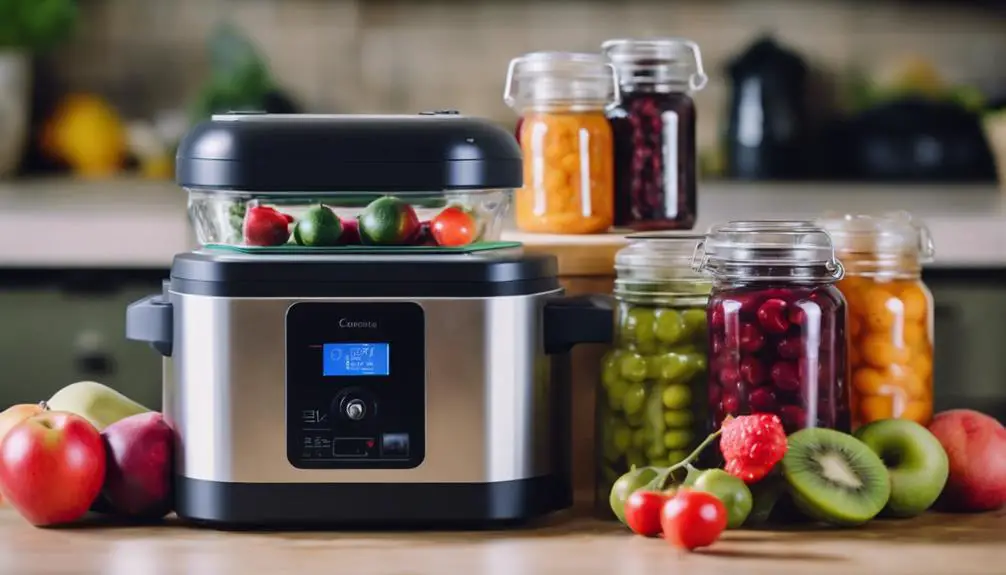
When comparing the cost of food preservation methods, it's important to consider both the upfront and ongoing expenses of vacuum sealing versus canning. Let's break it down in a simple way.
Here's a clear table to show the cost comparison:
| Expense Type | Vacuum Sealing | Canning |
|---|---|---|
| Initial Setup | Moderate-High | Low-Moderate |
| Materials | Bags (recurring) | Jars (reusable), Lids (recurring) |
| Equipment Maintenance | Low | Low |
At first glance, vacuum sealing may seem more expensive due to the cost of the sealer itself. However, the recurring cost mainly comes from purchasing bags. On the other hand, canning requires an upfront investment in reusable jars, but you'll need to buy new lids for each use. Both methods have low maintenance costs, making them cost-effective in the long run.
When deciding between vacuum sealing and canning, it's important to consider these costs in relation to your lifestyle and food preservation needs. It's not just about the financial aspect, but also about finding a method that suits your kitchen routine best. Understanding these costs will help you make an informed choice, which we'll explore further next.
Making the Right Choice
When it comes to choosing a preservation method, you want to pick the one that fits your lifestyle and preferences. It's not just about cost or shelf life, but also about finding the method that aligns with your culinary habits and storage needs. Here are four important things to consider:
- Space Efficiency: If you're tight on storage space, vacuum-sealed bags are a great option. They stack neatly and take up less room than jars, making them ideal for small kitchens or limited storage areas.
- Preservation Duration: If you're looking for long-term storage, canning is the way to go. It has the edge, especially for acidic foods like tomatoes and fruits that thrive in this environment. Canned foods can last for years on your pantry shelf.
- Ease of Use: Vacuum sealing is a straightforward and quick method, perfect for those who want to preserve in small batches or have limited time. It's as simple as placing your food in a bag, removing the air, and sealing it shut. This makes it an ideal choice for busy individuals or families.
- Type of Food: Vacuum sealing works best for high-moisture foods and those prone to crushing. It helps to retain the freshness and texture of delicate items like seafood or berries. On the other hand, canning is great for acidic foods and large harvests. The high heat and pressure used in the canning process ensure safety and long shelf life.
Frequently Asked Questions
Can Vacuum-Sealed Foods Be Stored at Room Temperature, or Do They Require Refrigeration?
Vacuum-sealed foods can be stored at room temperature, but it depends on the type of food. Dry goods, such as rice, pasta, or beans, can be safely stored at room temperature without the need for refrigeration. However, it's important to note that foods with moisture, like meats or prepared meals, should always be refrigerated to prevent spoilage and ensure food safety.
When it comes to storing vacuum-sealed meats, refrigeration is crucial. The vacuum-sealed packaging helps to extend the shelf life of the meat, but it doesn't eliminate the need for cold storage. By keeping the meat refrigerated, you can maintain its freshness and prevent the growth of harmful bacteria.
Similarly, prepared meals that have been vacuum-sealed should also be stored in the refrigerator. These meals often contain perishable ingredients like vegetables, sauces, or dairy products, which can spoil if left at room temperature. Refrigeration not only helps to keep the food safe but also preserves its taste and quality.
It's worth mentioning that some vacuum-sealed foods, like certain types of cheese or cured meats, can be stored at room temperature for short periods. However, it's always best to check the specific recommendations provided by the manufacturer or follow the instructions on the packaging.
To ensure the longest shelf life and maintain food safety, it's generally recommended to refrigerate vacuum-sealed foods that contain moisture. This helps to preserve their quality and prevent the growth of harmful bacteria. So, when in doubt, it's always safer to err on the side of refrigeration.
How Does the Nutritional Value of Foods Compare When Preserved Through Vacuum Sealing Versus Canning?
When it comes to preserving the nutritional value of foods, vacuum sealing is a better option compared to canning. This is because the process of vacuum sealing does not involve high heat, which can potentially degrade the vitamins and minerals in the food. By avoiding high heat, vacuum sealing helps to retain more nutrients, making it a superior method for preserving the nutritional value of foods.
Unlike canning, which requires the food to be exposed to high temperatures for an extended period of time, vacuum sealing involves removing the air from the packaging and sealing it tightly. This airtight seal prevents the food from being exposed to oxygen, which can cause oxidation and nutrient loss. In addition, the lack of high heat in vacuum sealing helps to preserve the natural color, flavor, and texture of the food.
Another advantage of vacuum sealing is that it allows for longer storage periods without compromising the nutritional value of the food. The airtight seal created by vacuum sealing helps to prevent the growth of bacteria, mold, and other microorganisms that can spoil the food. This means that you can store vacuum-sealed foods for longer periods without worrying about nutrient degradation or spoilage.
In terms of specific examples, vacuum sealing is particularly beneficial for preserving the nutritional value of fruits and vegetables. These foods are rich in vitamins and minerals, which can be easily lost during the canning process. By vacuum sealing fresh fruits and vegetables, you can retain more of their nutritional value and enjoy the benefits of these essential nutrients.
When it comes to product recommendations, there are various vacuum sealing machines available in the market that can help you preserve the nutritional value of your foods. Some popular options include the FoodSaver Vacuum Sealer and the NutriChef Vacuum Sealer. These machines allow you to easily vacuum seal your foods and extend their shelf life while maintaining their nutritional value.
Are There Specific Foods That Should Not Be Preserved Using Either Vacuum Sealing or Canning Due to Safety Concerns?
Certain foods should not be preserved using vacuum sealing or canning due to safety concerns. These include dairy products, raw mushrooms, and soft cheeses. It is important to prioritize food safety when deciding on preservation methods.
Preserving dairy products like milk, yogurt, and cream through vacuum sealing or canning is not recommended. These products have a high moisture content, which creates an ideal environment for bacteria growth. The lack of oxygen in vacuum-sealed or canned containers can promote the growth of harmful bacteria, such as Clostridium botulinum, which can cause botulism. It's best to consume dairy products fresh or use other preservation methods like freezing.
Raw mushrooms are also not suitable for vacuum sealing or canning. Mushrooms have a high water content and are prone to spoilage. When vacuum sealed or canned, the lack of oxygen can lead to the growth of anaerobic bacteria, which can cause foodborne illnesses. It's best to store mushrooms in a cool, dry place or use other preservation methods like dehydrating.
Soft cheeses, such as brie, camembert, and blue cheese, should not be preserved using vacuum sealing or canning. These cheeses have a soft and delicate texture, making them susceptible to spoilage and the growth of harmful bacteria. Vacuum sealing can compress the cheese and change its texture, while canning can alter its flavor. It's recommended to consume soft cheeses fresh or use alternative preservation methods like wrapping them in wax paper and storing them in the refrigerator.
When it comes to food preservation, it's crucial to consider the safety of the specific foods being preserved. Dairy products, raw mushrooms, and soft cheeses are better preserved using other methods to ensure food safety. By understanding the limitations of vacuum sealing and canning, we can make informed decisions to keep our food safe and enjoyable.
How Do Environmental Impacts Compare Between Vacuum Sealing and Canning in Terms of Packaging Waste and Energy Consumption?
In my experience, vacuum sealing is a more eco-friendly option for food storage compared to canning. This is because vacuum sealing produces less packaging waste and requires less energy.
When it comes to packaging waste, vacuum sealing allows for the use of reusable bags or containers. These bags can be washed and reused multiple times, reducing the amount of waste generated. On the other hand, canning typically involves the use of single-use glass jars or metal cans, which often end up in landfills after use.
In terms of energy consumption, vacuum sealing requires less energy compared to canning. The process of vacuum sealing involves removing air from the packaging, which helps to preserve the freshness of the food. This process is relatively quick and does not require high temperatures or prolonged cooking times. In contrast, canning involves heating the food in jars at high temperatures for a specific period of time to ensure preservation. This can consume more energy, especially if large batches of food are being canned.
To put it into perspective, let's consider an example. Imagine you have a surplus of fresh fruits that you want to store for later use. If you choose to vacuum seal them, you can use reusable vacuum-seal bags and simply remove the air to preserve the fruits. This method not only reduces packaging waste but also saves energy. On the other hand, if you decide to can the fruits, you will need to use single-use glass jars, which contribute to packaging waste. Additionally, the canning process requires heating the jars for an extended period of time, consuming more energy.
Can the Materials Used for Vacuum Sealing (Like Plastic Bags) or Canning (Like Jars and Lids) Be Reused or Recycled to Minimize Waste?
When it comes to reducing waste and being eco-friendly, it's important to consider the materials used for vacuum sealing and canning. While both methods can help extend the shelf life of food and reduce food waste, the materials they use differ in terms of reusability and recyclability. Let's take a closer look at each.
Vacuum sealing bags are commonly made of plastic, which is known for its durability and ability to create an airtight seal. However, these bags are generally less reusable compared to canning jars. After being used once, they can become compromised or damaged, making them less effective for future use. Additionally, they can be difficult to clean thoroughly, especially if they have been used to store perishable items like meat or fish.
On the other hand, canning jars and lids are typically made of glass and metal, respectively. Glass jars are highly reusable and can be easily cleaned and sterilized for future use. They can also be used for various purposes beyond canning, such as storing pantry staples, organizing small items, or even serving as drinking glasses. Metal lids can be reused to some extent, but they may need to be replaced after a few uses to ensure a proper seal.
When it comes to recycling, both plastic vacuum sealing bags and glass canning jars can find new life. However, the recycling process for each material is different. Plastic bags can usually be recycled through specialized recycling programs that accept plastic films and bags. It's important to check with your local recycling facilities to see if they accept these types of plastics. Glass jars, on the other hand, can be recycled through regular glass recycling programs. Simply remove the metal lids before recycling, as they may need to be recycled separately.
To minimize waste and make sustainable choices, consider using reusable options for vacuum sealing and canning. Instead of single-use plastic bags, consider investing in reusable silicone bags or containers made from durable materials like glass or stainless steel. These can be used repeatedly, reducing the need for disposable packaging.
Conclusion
Choosing between vacuum sealing and canning is like deciding between vinyl records and streaming for music. Both methods have their advantages and appeal to different preferences. Vacuum sealing offers convenience and ensures freshness, keeping up with the fast pace of modern life. On the other hand, canning represents tradition and resilience, reflecting a sense of self-sufficiency.
When it comes to costs, they play a background role, and the amount you spend will depend on your personal budget. Ultimately, the decision between vacuum sealing and canning should be guided by the rhythm of your kitchen and the needs of your pantry. It's not about finding the best method, but rather finding the right harmony that works for you.
Vacuum sealing is a modern technique that offers a range of benefits. By removing the air from the packaging, it helps to preserve the flavor, texture, and nutrients of the food. This method is particularly useful for storing fresh produce, meats, and leftovers. Imagine being able to enjoy the taste of a perfectly ripe tomato or a juicy steak even weeks after purchasing them. Vacuum sealing can make that possible.
On the other hand, canning has a long-standing tradition that's deeply rooted in preserving food. It involves heating the food in a jar to kill bacteria and sealing it tightly. Canning is often used for fruits, vegetables, and homemade sauces. The process of canning can be time-consuming, but it allows you to enjoy the taste of summer fruits in the middle of winter or savor the flavors of your garden harvest long after the growing season has ended.
While both methods have their merits, it's important to consider your specific needs and preferences. If you value convenience and want to extend the freshness of your food, vacuum sealing is a great option. However, if you enjoy the process of preserving food and appreciate the connection to tradition, canning may be the way to go.
In terms of specific recommendations, there are several vacuum sealers and canning kits available on the market. For vacuum sealing, popular brands include FoodSaver and NutriChef. These machines are designed to remove air and seal the packaging efficiently. For canning, Ball is a well-known brand that offers a range of canning jars, lids, and accessories.
In conclusion, the choice between vacuum sealing and canning is a personal one. It's about finding the right balance between convenience and tradition, and considering your budget and specific needs. Whether you opt for the modern convenience of vacuum sealing or the time-honored tradition of canning, both methods can help you preserve the taste and quality of your food for longer periods.
